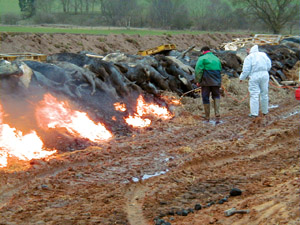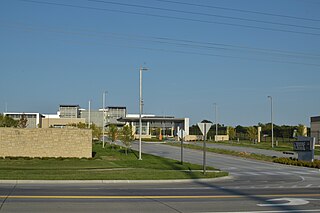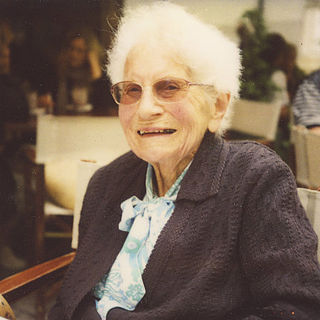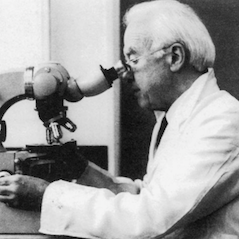Related Research Articles

A biosafety level (BSL), or pathogen/protection level, is a set of biocontainment precautions required to isolate dangerous biological agents in an enclosed laboratory facility. The levels of containment range from the lowest biosafety level 1 (BSL-1) to the highest at level 4 (BSL-4). In the United States, the Centers for Disease Control and Prevention (CDC) have specified these levels in a publication referred to as BMBL. In the European Union, the same biosafety levels are defined in a directive. In Canada the four levels are known as Containment Levels. Facilities with these designations are also sometimes given as P1 through P4, as in the term P3 laboratory.

Plum Island Animal Disease Center (PIADC) is a United States federal research facility dedicated to the study of foreign animal diseases of livestock. It is a national laboratory of the Department of Homeland Security (DHS) Directorate for Science and Technology (S&T), and operates as a partnership with the U.S. Department of Agriculture (USDA). The facility's director is Larry Barrett.

The Department of Computer Science and Technology, formerly the Computer Laboratory, is the computer science department of the University of Cambridge. As of 2023 it employed 56 faculty members, 45 support staff, 105 research staff, and about 205 research students. The current Head of Department is Professor Alastair Beresford.

The outbreak of foot-and-mouth disease in the United Kingdom in 2001 caused a crisis in British agriculture and tourism. This epizootic saw 2,000 cases of the disease on farms across most of the British countryside. Over 6 million cows and sheep were slaughtered on farms in an eventually successful attempt to halt the disease. Cumbria was the worst affected area of the country, with 893 cases.

The Pirbright Institute is a research institute in Surrey, England, dedicated to the study of infectious diseases of farm animals. It forms part of the UK government's Biotechnology and Biological Sciences Research Council (BBSRC). The institute employs scientists, vets, PhD students, and operations staff.

Texas A&M Veterinary Medical Diagnostic Laboratory (TVMDL) is an integral part of the Texas A&M University System. It consists of four lab locations spread across Texas; two full-service laboratories located in Canyon and College Station and two poultry laboratories in Center and Gonzales.
Erich Traub was a German veterinarian, scientist and virologist who specialized in foot-and-mouth disease, Rinderpest and Newcastle disease. Traub was a member of the National Socialist Motor Corps (NSKK), a Nazi motorist corps, from 1938 to 1942. He worked directly for Heinrich Himmler, head of the Schutzstaffel (SS), as the lab chief of the Nazis' leading bio-weapons facility on Riems Island.

The National Bio and Agro-Defense Facility (NBAF) is a biosafety level 4 research laboratory in Manhattan, Kansas, operated by the United States Department of Agriculture. The facility opened in June 2023. The facility is designed to combat biological threats involving human, zoonotic, and foreign animal diseases. The NBAF replaced the aging Plum Island Animal Disease Center (PIADC) on Plum Island, New York. The primary research tenants of the facility are the Agriculture Research Service (USDA-ARS) and Animal Plant Health Inspection Service, Veterinary Services (USDA-APHIS-VS). Construction on the 574,000-square-foot (53,300 m2) facility officially began in May 2015, and was scheduled to be completed by May 2021. The ongoing COVID-19 pandemic, however, has delayed scheduled commissioning to October 2021, followed by further delays to Spring, and finally summer 2023. Operations will be fully transferred from the Plum Island facility by 2023. The facility employs between 250 and 350 people. The facility is a constituent member of the Biosafety Level 4 Zoonotic Laboratory Network, and is currently led by Alfonso Clavijo.

The 2007 United Kingdom foot-and-mouth outbreak occurred when the discharge of infectious effluent from a laboratory in Surrey led to foot-and-mouth disease (FMD) infections at four nearby farms. The infections were detected via regular livestock testing by the Department for Environment, Food and Rural Affairs (Defra).
The 1967 United Kingdom foot-and-mouth outbreak was a major outbreak of foot and mouth disease in the United Kingdom. The only centre of the disease, in contrast to the three concentrated areas in the 2001 crisis, was on the Wales border with Shropshire. France and other European countries were also affected by the crisis.
Keith Cameron Meldrum CB, MRCVS, DVSM, HonFRSH was the United Kingdom's Chief Veterinary Officer from June 1988 to April 1997.

Foot-and-mouth disease (FMD) or hoof-and-mouth disease (HMD) is an infectious and sometimes fatal viral disease that primarily effects even-toed ungulates, including domestic and wild bovids. The virus causes a high fever lasting two to six days, followed by blisters inside the mouth and near the hoof that may rupture and cause lameness.
Malcolm Andrew Ferguson-Smith, is a British geneticist.
Brian Derek Perry, OBE is a British veterinary surgeon and epidemiologist renowned for the integration of veterinary epidemiology and agricultural economics, as a tool for disease control policy and strategy development, and specialised in international agricultural development. He is an Honorary Professor at the University of Edinburgh, a visiting professor at the Nuffield Department of Clinical Medicine, University of Oxford.

Winifred Mary Brancker (1914–2010) was an English veterinary surgeon, best known as the first woman to become president of the British Veterinary Association since its foundation in 1881.

Alan Glynn (1923-2014) was a British physician and bacteriologist.

Ernest Cotchin was Professor of Veterinary Pathology at the Royal Veterinary College between 1963 and 1982. He was Vice-Principal of the Royal Veterinary College from 1974 until 1988, and a world expert on neoplasia in domestic mammals. Cotchin's entire career was based at the Royal Veterinary College and, together with contributions to learned journals, he wrote a history of the Royal Veterinary College that was published posthumously with the help of a former colleague, Valerie Carter. His obituary in The Independent claimed his greatest achievements were in comparative pathology for which he was made a Fellow of the Royal College of Pathologists in 1964.

Sir Percy John Luxton Kelland, known as Sir John Kelland, was the Chief Veterinary Officer in the Diseases of Animals Branch at the Ministry of Agriculture and Fisheries between 1932 and 1938.
References
- 1 2 3 4 5 Reynolds, L.A.; Tansey, E.M., eds. (2003). Foot and mouth disease : the 1967 outbreak and its aftermath (PDF). London: Wellcome Trust Centre for the History of Medicine at UCL. ISBN 9780854840960 . Retrieved 5 September 2020– via History of Modern Biomedicine Research Group.
- ↑ "Lab Services Ltd (LSL) - About". Archived from the original on 27 June 2016.